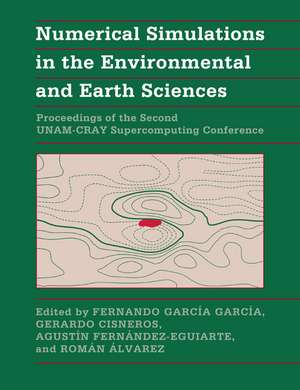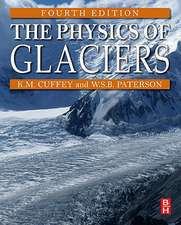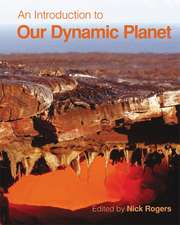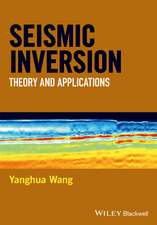Numerical Simulations in the Environmental and Earth Sciences: Proceedings of the Second UNAM-CRAY Supercomputing Conference
Editat de Fernando García-García, Gerardo Cisneros, Agustín Fernández-Eguiarte, Román Álvarezen Limba Engleză Paperback – 7 ian 2007
Toate formatele și edițiile
| Toate formatele și edițiile | Preț | Express |
|---|---|---|
| Paperback (1) | 322.89 lei 6-8 săpt. | |
| Cambridge University Press – 7 ian 2007 | 322.89 lei 6-8 săpt. | |
| Hardback (1) | 861.66 lei 6-8 săpt. | |
| Cambridge University Press – 27 sep 1997 | 861.66 lei 6-8 săpt. |
Preț: 322.89 lei
Nou
Puncte Express: 484
Preț estimativ în valută:
61.78€ • 64.51$ • 51.13£
61.78€ • 64.51$ • 51.13£
Carte tipărită la comandă
Livrare economică 04-18 aprilie
Preluare comenzi: 021 569.72.76
Specificații
ISBN-13: 9780521026048
ISBN-10: 0521026040
Pagini: 300
Ilustrații: 121 b/w illus. 19 tables
Dimensiuni: 187 x 243 x 17 mm
Greutate: 0.54 kg
Editura: Cambridge University Press
Colecția Cambridge University Press
Locul publicării:New York, United States
ISBN-10: 0521026040
Pagini: 300
Ilustrații: 121 b/w illus. 19 tables
Dimensiuni: 187 x 243 x 17 mm
Greutate: 0.54 kg
Editura: Cambridge University Press
Colecția Cambridge University Press
Locul publicării:New York, United States
Cuprins
Participants; Scientific committee; Organizing committee; Preface; Part I. General Circulation Models and Global Change: 1. A general circulation model of the atmosphere-ocean system; 2. Coupled ocean-atmosphere modeling: computing and scientific aspects; 3. The OCCAM global ocean model; 4. Climatic asymmetries relative to the equator; 5. On the use of a general circulation model to study regional climate; 6. A numerical study of the circulation and sea surface temperature of the Gulf of Mexico; 7. Pacific region CO2 climate change in a global coupled climate model; 8. Prospects and problems in modeling the impacts of climate change in Latin America; 9. PIXSAT, a digital image processing system in a CRAY-UNIX environment; 10. Marine productivity seasonal forecast along the Ecuadorian coastal zone based on physical models of ENSO; 11. Land cover classification by means of satellite imagery and supercomputer resources; Part. II. Dispersion and Mesoscale Modeling: 12. Environmental applications of mesoscale atmospheric models; 13. An integrated air pollution modeling system: application to the Los Angeles Basin; 14. An h-adapting finite element model for atmospheric transport of pollutants; 15. The applicability of a mesoscale model in the Valley of Mexico during extreme air pollution episodes; 16. Mexico city air quality simulations under different fuel consumption scenarios; 17. Numerical modeling of pollutant particle diffusion in the atmospheric boundary layer; 18. Investigating the dispersion inside idealized urban street canyons using a k-epsilon turbulence model; 19. Coupling of an urban dispersion model and an energy-budget model; 20. A mesoscale meteorological model to predict windflow in the Valley of Mexico; 21. Some experiments with a three-dimensional semi-lagrangian and semiimplicit cloud model; 22. Large eddy modeling of stratocumulus clouds; Part III. Geophysical Data Assimilation: 23. Computational aspects of Kalman filtering and smoothing for atmospheric data assimilation; 24. Computational aspects of Goddard's physical-space statistical analysis system (PSAS); 25. A study on the influence of the Pacific and Atlantic SST on the northeast Brazil monthly precipitation using singular value decomposition; 26. Numerically efficient methods applicable to the eigenvalue problems arising in linear stability analysis; 27. Use of canonical correlation analysis to predict the spatial rainfall variability over northeast Brazil; 28. Identification of the ITCZ axis by computational techniques; 29. Variational assimilation of acoustic tomography data and point observations: some comparisons and suggestions to perform error analysis; Part IV. Methods and Applications in Geophysics: 30. Do man-made obstacles produce dynamical p-wave localization in Mexico City earthquakes?; 31. Domain decomposition methods for model parallelization; 32. Parallelization using th-collocation; 32. A method for simultaneous estimation of multiphase relative permeability and capillary pressure functions.
Recenzii
'… there are numerous excellent articles and the book gives a reasonable introduction to those researchers and graduate students who have some knowledge to the topic.' D. B. Ingham, Contemporary Physics
Descriere
A wide-ranging account of modelling environmental and earth processes through numerical simulations.











